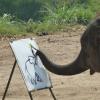Ok, fair enough, since most of you asked the same questions this time Ill try to ramble less and be more concise.
But I have to start-evolve from scratch. Ill try and be as short as possible and precise.
-------------
Anyway, here goes.
Life is observed as a phenomena of integrating matter into self-replicating schemas.
Matter is integrated by self-replication itself, so making it a part of the self-replicating schema and increasing its growth rate.
Replicator is a form of matter facilitating a self-replication schema.
Life source is all the specific forms of matter and energy required for sustaining the behaviour of replicators of a specific self-replicating schema.
Life source is represented by nutrients and energy such as the minerals from the soil or the sun, or water from a river-rain or another plant or animal.
Death source represents all the specific conditions and that cause irreparable damage to replicators in terms of facilitating a specific self-replicating schema.
A death source can a difficult obstacle causing injuries, climate-chemical-radiational conditions and also another plant or animal by making it its life source.
The behaviour of the replicator through which it facilitates a self-replication schema can be observed to fall into following categories.
Acquiring is the observed behaviour of the replicator which serves the purpose of acquiring life source in order to replicate.
Avoidance is the observed behaviour of the replicator which serves the purpose of death source avoidance in order to survive to acquire and replicate.
All this doesn't really discern robot replicators from the ones we consider life so we must discern further.
Mutation is observed as a change of the form of a replicator inducing a chance of generating a new self-replicating schema via the newly formed replicator.
In order to reduce risk of all the replicators of a given schema losing replicating ability through spontaneous mutation, it is best set to happen during replication and it is observed to be so in most cases(simple life has methods of exchanging genetic material between replicators, this is a weak violation of this rule with some safety mechanism probably). This ensures that the original replicator will still keep an ability to self-replicate even if the mutated replicator fails to spawn a successful self-replicating schema.
Selection of self-replicating schemas is observed to result from population reduction of those self-replicating schemas whose replicators fail to avoid their
death source and is also observed to result from lack of
growth of those self-replicating schemas whose replicators fail to acquire the required life source(due to competition or otherwise caused failure).
Evolution of life is observed as increased integration (increased life sourcing) or reintegration (recycling - food chain) of matter resulting from mutation and selection generating new distinct self-replicating schemas over time.
Selection mechanisms as explained cause evolution to generate new distinct self-replicating schemas or replicators that are relatively more successful from old ones in terms of acquiring and/or avoiding in order to replicate.
This means that either:
a) acquiring for replication is relatively sacrificed to provide energy/time for increased avoidance mechanisms and this results in better survival of existing population at the cost of replication or reduced population growth.
b) avoidance is relatively sacrificed to provide for increased acquiring and replication resulting in increased population growth but increased risk to existing population.
It is immediately obvious that increased selection pattern a) results from the self-replicating schema being overwhelmed by its death source while increased selection pattern b) results from the self-replicating schema being overwhelmed by competition for its life source
This is enough to define the basic balances of simple life, but is not what we're after really. As said, complex life was enabled by sexual reproduction and ageing so let us try and explain that now.
The biggest event in evolution is the creation of the eukaryotic cell which features sexual reproduction.
Sexual reproduction spawned a meta entity called
gene pool. From the perspective of the gene pool, its replicators refresh it every now and then with beneficial and less beneficial genes..
Sexual reproduction inverted the replicator to become a pawn of the newly evolved
organisation of life called the gene pool rather than its own "master".
The organisation of life is upheld by the need of replicators to find each other to sexually reproduce and thus each time make a deposit into the gene pool.
It seems like this is a maladaptation as the replicators need to find each other results in fewer replications, so what is the tradeoff for such an organisation to evolve?
The tradeoff is obviously the gene pool - the organisation itself, but how does it prove to be an advantage for life?
It provides for "conditions" for depositing genes in the pool which keep it filled with healthier genes.
A replicator is forbidden to deposit genes before reaching "maturity". This proves he has minimum function to survive "long enough" to "prove" himself worthy of depositing genes and replicating (could be seen as reward from the gene pool, just to illustrate better how the flow of life flows).
Single cell and even some multi cell eukaryotic life forms preserved asexual reproduction but most didn't due to the following:
As sexual reproduction of cells evolved, asexual reproduction could be "sidetracked" towards building a body of cells. This is the evolution of multicellular life form. A cell divides asexually and coordinated via various mechanisms into a body of differentiated cells performing a different task.
The body of a multicellular life form is simply more evolved acquiring and avoiding behaviour resulting from "hijacking" the now optional asexual reproduction method.
The single cell instead of immediately beginning replication starts to build a body around it that will eventually help it survive to sexually reproduce with another such life form. The multicellular body enables acquiring of new life sources and avoidance of more death source.
The protein guided body development out of a single cell is a complex timed process which can easily go wrong(errors integrate over time), again causing a need to reject undeveloped bodies from allowing them to deposit in the gene pool as a gene that disrupts multicellular body producing processes would prove to be very unhealthy for the subscribers of the gene pool.
Remember, growing of the body is an evolution of tools support both acquiring and avoiding behaviour. It is in fact an evolution of the old replicating ability - asexual reproduction.
It seems that multicellular life forms invest quite the resource into their acquiring and avoiding behaviour tools. This causes quite a delay in reproduction compared to unorganised life. But the payoff of new life sources and avoidance of death sources seems worthy. The gene pool provides a payoff in terms of providing essential selection mechanisms for this newly evolved behaviour of growing bodies.
The growing bodies are investment into the future ability of a replicator to survive and replicate but how much should be invested? A body could be set to grow indefinitely before allowing time and resources to reproduce instead of growth. This may make it more sturdy in terms of avoidance but if it still somehow dies before replicating all the investment is literally lost. So,
the gene pool needs to regulate time to mature to make sure it gets enough deposits or in other words to make sure its subscribers deposit before a death source gets them but after maturation of the body. If a "bad behaviour gene" survives development of the body there is nothing stopping it from polluting the gene pool. For example, a gene that causes worse acquiring after maturing would persist indefinitely if the species did not have a death source. The reduced replication this would cause wouldn't extinct the gene from the pool. Such subscribers would still make regular albeit slower deposits and the bad gene might infest the entire population of the gene pool subscribers before a death source pressures it out. So,
an artificial death source is provided through ageing of the mature body. Giving it a time limit for making deposits to the gene pool. A gene infests the pool if it replicates more often than its replicators die out. In order to reduce this tendency ageing causes artificial timed deaths.
This makes sure that bad genes will be pressured out. Only genes whose ability doesn't impair the life form to make enough deposits to overcome the ageing vs. reproduction balance will spread.
If the gene pool provides steady evolution in this way that also means it is worthwhile to induce death of bodies which will become more and more obsolete relative to new ones being created. It then also makes sense kill the old bodies to allow more life source for new better ones.
Mutations are more often degenerating that beneficial so a gene pool can afford to age its bodies only if its population is large enough to guarantee a beneficial mutation among future generations and enough replicating speed to make up for age related deaths. If this doesn't happen the population and the gene pool will in fact start to degenerate.
Remember, selection process as defined before mostly selects for survival (which provides for many hardly alive species of simple life). Ageing setting a time limit for reproduction in fact causes a shift in balance of the selection process to select for acquiring and reproduction. Those who acquire and reproduce most in a time limit are selected for. Of course avoidance is still selected for, but secondary now.
This whole setup now superpowers evolution. Bodies allow new life sources and evasion of death sources. Selection mechanisms now force evolution through subscription to an organisation(for driving evolution/selection) rather than wait for it to happen spontaneously.
The fact that this whole setup is enabled through sexual reproduction and sexual reproduction requires coordination meaning signalling and understanding signals - sets the platform for evolution of more advanced organisations(for driving of evolution/selection) of later life, harems, mammal groups and even social/business organisations of humans.
It is obvious that unicellular eukaryotic life and simple is still "on the verge" of this mechanism providing a payoff. But the body building multicellular life depends on the gene pool to select properly for body building behaviour.
Ever growing plants basically lack ageing so their deaths are truly provided by senescence and or disease/parasites/other damage/violence. Ever growing plants are basically only limited by their ability to rise from the land level or in other worse to push nutrients to required heights. The static nature of plant bodies stemming from a lack of nervous system makes this feasible and the payoff of large bodies for getting at the sun and deep into the ground is obvious. This violates ageing payoff for this kind of life but as said, it looks less "lively". But even so, many plants have various ageing mechanisms and many of them are seasonal proving a fixed age limit.
Animal life with nervous systems on the other hand develops increasing difficulties to sustain an ever-growing body. The ever growing body would have to adapt behaviour and life sources to its size providing a complex goal for evolution. The more complex the nervous system is, the bigger the problems are if the body doesn't reach a final mature state to tune behaviour in. It is seen as evolution progressed that the final mature state of newer life forms evolved to a more and more fixed size or differentiation level for maturity.
Stress during maturing is detected by the nervous systems and quickens maturing in order to make sure the life form survives to replicate and deposit. Increased stress is matched by reduced maturing time keeping the selection of maturing proving worthiness intact.
Stress during ageing is also detected by the nervous system and increasingly degenerates the body and causes faster ageing as repair mechanism are increasingly shut down to facilitate death by anything that damages/stresses the body further. While ageing did shift the balance of selection towards acquiring, the way it is implemented(shutting down repairs) also provides selection for avoidance to still depend on external death sources rather than a precisely timed death.
A species without a serious death source and with unlimited access to life source will evolve its immune and repair systems to prolong its life past maturing. This is allowed as such species has no competition but obviously it can't result in spectacular life prolongation any time soon, and by the time it does the species will compete with itself for life source due to a rapidly growing(undieing) population again causing a reduction in life time.
As evolution went on new organisations of evolution/selection/life evolved out of the old ones, providing even more selection of even more advanced behaviour. The gene pool provides basic body building selection. The nervous system upgrades the gene pool to provide advanced behaviour selection. Then it upgrades again to provide behaviour learning uncoupling it from the gene pool into a new meta-entity that carries the "behaviour pool" - the group. Groups compete via their behaviour, part of which derives from the gene pool and part from the knowledge of the group.
Uhmm... too tired now to go on, shortened it a bit at the end so... I have a lot more if I go into the nervous system adaptations, I just quickly summarised them in the last paragraph. I hope we can discuss this part before going into detail about the nervous system. As timed maturing and ageing is modulated by the nervous system(which matures and ages as well) responding to responding to various types of stress at various levels, this provides for the n-tier sublimating complexity of ageing.
Anyway, I hope this is readable and understandable. The last paragraph probably isn't but that can be resolved after discussing this.
Edited by addx, 05 April 2014 - 09:12 PM.




















































